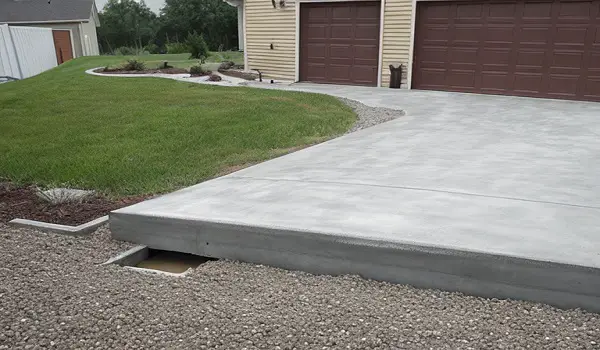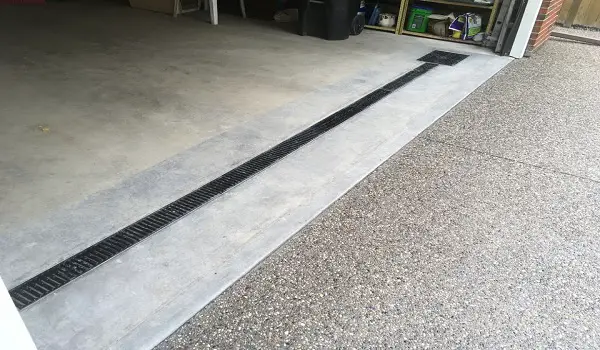Garage Drainage System
A garage is more than just a space to park your vehicle; it’s a versatile area that can serve as a workshop, storage space, or even an extension of your living space.
With its susceptibility to water infiltration, a garage can quickly become a haven for water damage, which not only compromises the structural integrity of the space but also damages your belongings.
To combat this issue, a garage drainage system can prove to be an invaluable asset.
In this article, I will share my knowledge of garage drainage systems with you. I will discuss the different types of systems available, the installation process, the associated costs, and the many benefits of having a well-functioning drainage system in your garage.
What is a Garage Drainage System?

A garage drainage system is a specialized mechanism designed to redirect and manage excess water that may accumulate within or around your garage.
This water can originate from various sources, such as rainwater, melting snow, or even accidental spills. The primary objective of a garage drainage system is to prevent water from pooling on the floor, seeping into the walls, or causing other forms of water-related damage.
Why is a Garage Drainage System Important?
The importance of a garage drainage system cannot be overstated. Excessive water accumulation can lead to a range of problems, including mold growth, deterioration of building materials, and even compromised structural stability.
By installing an effective drainage system, you can safeguard your garage from potential water damage and its associated consequences.
Types of Garage Drainage Systems

Several types of garage drainage systems are available, each tailored to address specific drainage needs. Here are some common types:
- Floor Drains: These are strategically placed drains in the garage floor that collect water and direct it towards the sewer or a designated drainage area.
- Sump Pumps: Sump pumps are installed in a pit within the garage floor. They actively pump out excess water to prevent flooding.
- Gutters and Downspouts: These systems help divert rainwater away from the garage by collecting it from the roof and channeling it to a safe drainage area.
- Drain Tile: Also known as French drains, drain tiles consist of perforated pipes buried underground to redirect water away from the garage.
How to Install a Garage Drainage System
Installing a garage drainage system involves several key steps to ensure its effectiveness:
- Step 1: Choose the Right Type of Garage Drainage System: Assess your garage’s needs and select the most suitable drainage system.
- Step 2: Prepare the Site for Installation: Clear the area, mark the drainage path, and ensure proper slope for water flow.
- Step 3: Install the Drainage System: Follow manufacturer instructions to install the chosen system, whether it’s floor drains, sump pumps, or drain tiles.
- Step 4: Backfill the Site and Test the Drainage System: Replace soil and test the system by simulating water flow to confirm its functionality.
Cost of Garage Drainage Systems
The cost of installing a garage drainage system can vary based on factors such as garage size, drainage system type, and local labor costs. On average, the cost ranges from $1,500 to $3,000. While this might seem like an initial investment, the long-term benefits in terms of damage prevention far outweigh the cost.
Benefits of Garage Drainage Systems
The advantages of having a garage drainage system extend beyond mere water management:
- Prevent Water Damage: The primary benefit is the prevention of water-related damage to your garage structure and belongings.
- Improve Air Quality: By eliminating excess moisture, you enhance the air quality within the garage and reduce the risk of mold growth.
- Increase Home Value: A well-maintained garage equipped with a drainage system can add to your home’s overall value.
- Extend Garage Floor Life: Constant exposure to water can deteriorate garage floors. A drainage system helps extend their lifespan.
What are the signs of a clogged garage drain?
- Water backs up into the garage. This is the most obvious sign of a clogged garage drain.
- The drain gurgles or bubbles when water is running. This is a sign that air is being forced through the clog.
- There is a foul odor coming from the drain. This is a sign that the clog is allowing sewage to back up into the drain.
- The drain is slow to drain. This may be a sign of a partial clog.
How do I prevent my garage drain from clogging?
Here are some tips to help prevent your garage drain from clogging:
- Avoid pouring grease, oil, or other fats down the drain. These substances can solidify and clog the drain.
- Don’t flush disposable wipes, diapers, or other non-flushable items down the toilet. These items can also clog the drain.
- Regularly clean the garage floor and sweep up any debris that could fall into the drain.
- Install a strainer or screen in the drain to catch large objects.
- Have your garage drain inspected and cleaned by a plumber every few years.
How do I choose the right garage drainage system for my needs?
When choosing a garage drainage system, there are a few factors to consider:
- The size of your garage: A larger garage will require a larger drainage system.
- The type of flooring in garage: If you have a concrete floor, you will need a different type of drainage system than if you have a wood floor.
- The climate in your area: If you live in an area with cold winters, you will need a drainage system that is designed to prevent freezing.
How much does it cost to install a garage drainage system?
The cost of installing a garage drainage system will vary depending on the size and complexity of the system. In general, you can expect to pay between $500 and $2,000 for installation.
How do I maintain my garage drainage system?
Here are some tips to help you maintain your garage drainage system:
- Inspect the system regularly for signs of damage or clogs.
- Clean the system with a mild detergent and water solution every few months.
- Have the system professionally cleaned and inspected every few years.
Conclusion
In conclusion, as a homeowner who has had to deal with the aftermath of a flooded garage, I can attest to the importance of having a proper drainage system in place. A garage drainage system can help to protect your belongings from water damage, prevent mold growth, and extend the life of your garage.
There are a variety of garage drainage systems available, so it is important to choose the one that is right for your needs and budget. If you are not comfortable installing the system yourself, you can hire a professional to do it for you.
By taking the time to install a garage drainage system, you can help to protect your investment and ensure that your garage remains dry and functional for years to come.


